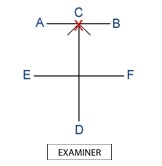Blue – Tag : Revision
You Are Here: Blue Tag
Blue Tag 5th Kup
PATTERN – Yul Gok 38 movements 
Yul gok is the pseudonym of the great philosopher and scholar Yi I (1536-1584 A.D.) nicknamed the “Confucius of Korea”. The 38 movements of this pattern refer to his birthplace on the 38th latitude and the diagram represents “scholar”.
New Techniques
- Hooking block
(Golcho makg)i
- Front elbow strike
(Ap palkup taerigi)
- Twin knife-hand block
(Sang sonkal makgi)
- Double forearm block
(Doo palmok makgi)
Power test techniques
- 1. Knife-hand strike to target at 45-degree angle
- Right and Left reverse turning kicks to target at 45 degree angle
1 Step Sparring – IIbo Matsoki
Attacking and Defending
(One step consists of counter attacks to a single punch in a walking stance. All attacks start from parallel ready stance, first on the right side then on the left side. Counter attacks to punches from either side must be practiced.)
The defender must execute efficient blocking or evading techniques followed by counter attacks consisting of a combination of hand or foot striking techniques or take down techniques. Regardless if the defender is to evade or take down their partner they should always follow through to “finish off’ their attacker.
- It is vital that all techniques are correct and focused on the proper target.
- Proper distance and control must be maintained.
- All kicks and punches must be fully extended to the target without striking.
Therefore demonstrating the exponent’s proficiency and control as expected of their grade
Pattern: Yul-Gok

Yul-Gok
Movements – 38
Ready Posture – PARALLEL READY STANCE
1. Move the left foot to B forming a sitting stance toward D while extending the left fist to D horizontally.
2. Execute a middle punch to D with the right fist while maintaining a sitting stance toward D.
3. Execute a middle punch to D with the left fist while maintaining a sitting stance toward D. Perform 2 and 3 in a fast motion.
4. Bring the left foot to the right foot and then move the right foot to A forming a sitting stance toward D while extending the right fist to D horizontally.
5. Execute a middle punch to D with the left fist while maintaining a sitting stance toward D.
6. Execute a middle punch to D with the right fist while maintaining a sitting stance toward D. Perform 5 and 6 in a fast motion.
7. Move the right foot to Ad forming a right walking stance toward AD while executing a middle side block to AD with the right inner forearm.
Your Pattern click on the video below to view
New Techniques Learn these
Questions You may be asked....
- How many moves in Yul Gok? – 38
- What is the meaning of Yul Gok? – Yul-Gok is the pseudonym of the great philosopher and scholar Yi l (1536-1584) nicknamed the ‘Confucius of Korea’. The 38 movements of this pattern refer to his birthplace on the 38 degree latitude and the diagram represents “scholar Gentleman & Samurai”.
- What is the purpose of the 1st & 4th move of Pattern Yul Gok? – It is a focus and measure of the distance between yourself and a target area.
- How do you perform Hocking block and what’s the Korean name? – Golcho makigi
- How do you perform X stance and what’s its purpose & the Korean name? – Kyocha sogi – The ability to turn & pivot quickly in any direction
- How do you perform twin knifehand block, what’s its purpose & the Korean name? – Sang Sonkal makgi – blocking 2 separate attacks at the same time with the knifehand.
- What is the difference between grading sparring and competition sparring? – Grading is to show control, movement, blocks and a wide variety of techniques. Competition is using your best techniques.
- How do you perform Double forearm block and what’s the Korean name? – Doo Palmok makgi
- What is the Korean for Reverse Turning kick and what part of the foot is used? – Bandae Dollyo Chagi using Dwichook (Back Heel)
- How do we get power into our techniques? – Speed & Acceleration, Breath Control (Kihap), Relaxation & Tension, Correct Technique, Body Mass
- What is the difference between jumping and flying techniques? – Jumping is to gain Height and Flying is to gain Distance.
- Name 6 blocks in English & Korean? – Najunde Bakat Palmok makgi, Kaunde An palmok makgi, Najunde Sonkal makgi, Chookyo makgi, Sang Palmok makgi, Sonkal Daebi makgi, Hechyo makgi, Dollymio makgi, Golcho makgi, Sang Sonkal makgi and Doo Palmok makgi.
- What is the Korean for downward (axe) kick and what part of the foot is used? – Naeryo chagi using Dwichook (Back Heel)
- What is the Korean for flat fingertip thurst? – Opun Sonkut Tulgi
- What is the Korean for Walking stance & describe it? – Gunnon Sogi – 50/50 weight, Length is one & half shoulder widths and one shoulder width wide, front foot points forward & back foot point 25 degrees outward, front leg bent and back leg straight, primary leg is in front
- What is the Korean for front elbow strike? – Ap Palkup Taerigi
- What does the colour Blue signify? – Blue signifies the heaven towards which the plant matures into a towering tree as training in Tae Kwon-Do progresses.
- Name 5 stances in English & Korean? – Gunnon (Walking), Annun (Sitting), Niunja(L stance), Narani (Parrallel), Charyot (Attention), Gojong (fixed), Moa (closed), Goburyo (bending), Kyocha ( “X” ) Sogi (Stance).
- What is the Korean for free sparring? – Jayu Matsoki
- What is the Korean for one step sparring? – Ilbo Matsogi
- What is the Korean for Jumping, Flying, Strike, Thrust, punch, kick, block & stance? – Twigi, Twimyo, Taerigi, Tulgi, Jirugi, Chagi, Makgi & Sogi
- One question from previous Gradings! – Remember and know your previous Theory




